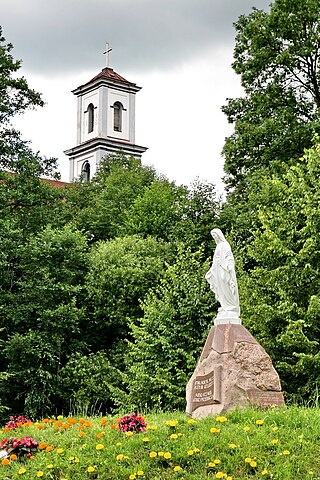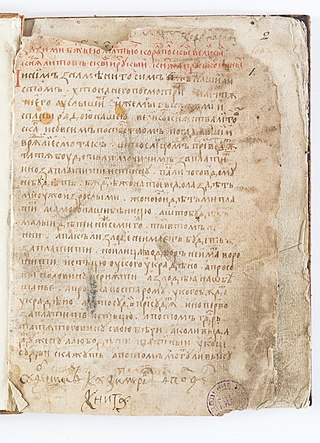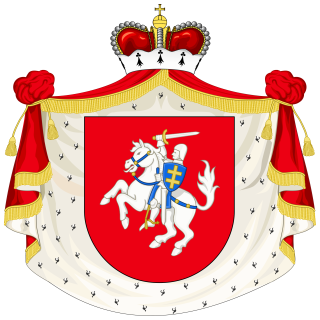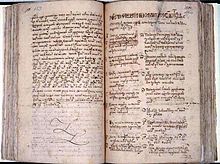
Casimir IV was Grand Duke of Lithuania from 1440 and King of Poland from 1447 until his death in 1492. He was one of the most active Polish-Lithuanian rulers; under him, Poland defeated the Teutonic Knights in the Thirteen Years' War and recovered Pomerania.

The Grand Duchy of Lithuania was a sovereign state in northeastern Europe that existed from the 13th century, succeeding the Kingdom of Lithuania, to the late 18th century, when the territory was suppressed during the 1795 partitions of Poland–Lithuania. The state was founded by Lithuanians, who were at the time a polytheistic nation of several united Baltic tribes from Aukštaitija, which by 1440, became the largest European state controlling an area from the Baltic Sea in the north to the Black Sea in the south.

The Lithuanian nobility or Lithuanian szlachta was historically a legally privileged hereditary elite class in the Kingdom of Lithuania and Grand Duchy of Lithuania consisting of Lithuanians from Lithuania Proper; Samogitians from Duchy of Samogitia; following Lithuania's eastward expansion into what is now Belarus, Ukraine and Russia, many ethnically Ruthenian noble families (boyars); and, later on, predominantly Baltic German families from the Duchy of Livonia and Inflanty Voivodeship. It traced its origins via Palemonids to Polemon II of Pontus.

The coat of arms of Lithuania is a mounted armoured knight holding a sword and shield, known as Vytis. Since the early 15th century, it has been Lithuania's official coat of arms and is one of the oldest European coats of arms. It is also known by other names in various languages, such as Waykimas, Pagaunė in the Lithuanian language or as Pogonia, Pogoń, Пагоня in the Polish, and Belarusian languages. Vytis is translatable as Chase, Pursuer, Knight or Horseman, similar to the Slavic vityaz. Historically – raitas senovės karžygys or in heraldry – raitas valdovas.

The Union of Grodno was a series of acts of the Polish–Lithuanian union between Kingdom of Poland and Grand Duchy of Lithuania. The first acts were signed in 1432 during the Lithuanian Civil War of 1431–1435. The acts confirmed the Union of Vilnius and Radom (1401). The Union established Sigismund Kęstutaitis as the Grand Duke of Lithuania and re-established Władysław II Jagiełło's seniority and dynastic interest in Lithuania.
The Act of Mielnik or Union of Mielnik was an attempt to unite the Kingdom of Poland with the Grand Duchy of Lithuania in 1501. It was not ratified by the Lithuanian Seimas or by the Polish Sejm. The Act of Mielnik remained just a political project. Despite the failure to unify two countries into a single state, Poland and Lithuania were under a personal union until the Union of Lublin of 1569.
The Statutes of Lithuania, originally known as the Statutes of the Grand Duchy of Lithuania, were a 16th-century codification of all the legislation of the Grand Duchy of Lithuania and its successor, the Polish–Lithuanian Commonwealth. The Statutes consist of three legal codes, all written in Chancery Ruthenian, translated into Latin and later Polish. They formed the basis of the legal system of the Grand Duchy and were "the first full code of laws written in Europe since Roman Law" and "a major milestone inasmuch as it is the first attempt to codify significant East European legal trends". The Statutes evolved hand-in-hand with the Lithuanian expansion to Slavic lands, thus the main sources of the statutes were Old Lithuanian Customary law, Old Slavic customary law, as well as the nobility privileges in Poland, Magdeburg Rights, international treaties and royal charters and proclamations of the 12th to 14th centuries.

The Cathedral Basilica of St Stanislaus and St Ladislaus of Vilnius is the main Catholic cathedral in Lithuania. It is situated in Vilnius Old Town, just off Cathedral Square. Dedicated to the Christian saints Stanislaus and Ladislaus, the church is the heart of Catholic spiritual life in Lithuania.

Nemenčinė ( is a city in Vilnius district municipality, Lithuania, it is located only about 7 kilometres north-east of Vilnius. Close to Nemenčinė forest was planted which forms a sentence Žalgiris 600 visible from the air.

Jonas Gostautas or Goštautas was a Lithuanian nobleman from the Grand Duchy of Lithuania of the Gasztołd (Goštautai) noble family, a politician and skillful land owner. He served as Chancellor of Lithuania between 1443 and 1458 and was a very close advisor and mentor to Casimir IV Jagiellon before he became the third Jagiellonian King of Poland. Gostautas was not his surname, but a pagan Lithuanian given name retained after baptism by his immediate ancestor, while Jonas was his Christian name. His heirs, e.g., his sons like Martynas Goštautas, perhaps inherited the name as a surname. In 1413 at the Union of Horodło, Jonas was adopted by the Polish nobles into the Abdank clan.

Casimir's Code, also known as the Sudebnik of 1468, was a legal code adopted by Grand Duke of Lithuania and King of Poland Casimir IV Jagiellon with the approval of the Lithuanian Council of Lords. It was the first attempt to codify the laws of the Grand Duchy of Lithuania. The code prescribed punishment for property crimes and limited court procedures. Much of the legal system was left uncodified and was governed by customs.
The Lithuanian Council of Lords was the main permanent institution of central government in the Grand Duchy of Lithuania active in its capital city of Vilnius.
Mikhailo Olelkovich was a noble from the Olelkovich family of the Grand Duchy of Lithuania. He was the brother of Prince Simeon Olelkovich of Kiev and cousin of Grand Prince Ivan III of Moscow. Mikhailo was allegedly involved both in bringing the Judaizer Heresy to Novgorod and the failed defection of the city to the Grand Duchy of Lithuania in 1471. He also organized a coup against Casimir IV Jagiellon, King of Poland and Grand Duke of Lithuania, but was discovered and executed in 1481. Mikhailo's son Semen continued the family line.
The sejm was an early parliament in the Grand Duchy of Lithuania. It was active from 1445 to 1569, when it was officially abolished by the Union of Lublin. The Sejm was an irregular gathering of the Lithuanian nobility, called as needed by the Grand Duke or during an interregnum by the Lithuanian Council of Lords. The meetings would usually last one or two weeks. Sejm gradually evolved from a meeting of the most powerful magnates to a full legislative institution representing all of the nobility. The Sejm was not the main political player as it was overshadowed by the Council of Lords. The Union of Lublin created a new state, the Polish–Lithuanian Commonwealth, and joined the Sejm of Lithuania with Sejm of Poland into one Sejm of the Polish–Lithuanian Commonwealth. However, the Sejm continued to convene under the name of Lithuanian Convocation. In total there were 40 Sejm and 37 Convocations.

Walerian Protasewicz was bishop of Lutsk (1549–1555) and Vilnius (1555–1579). Born to a family of petty Ruthenian nobles (szlachta), Protasewicz worked as a scribe, notary, and secretary at the chancellery of the Grand Duchy of Lithuania until his appointment of bishop. He was politically active and was one of the lead Lithuanian negotiators for the Union of Lublin in 1569. He neglected religious matters and allowed the Reformation to spread. In the last decade of his life, he invited the Jesuits to the Grand Duchy of Lithuania and funded the Jesuit college in Vilnius. He obtained papal and royal privileges to convert the college into Vilnius University in 1579. He donated his personal library to what became the Vilnius University Library. The university soon became a spiritual and cultural center of the Grand Duchy of Lithuania as well as the major center of the Counter-Reformation.

The House of Olelkovych was a 15th–16th-century princely family from the Grand Duchy of Lithuania. Their main possession was the Duchy of Slutsk–Kapyl. They are sometimes known as Slutskys. They were descended from the Lithuanian Gediminids and Ruthenian Rurikids. According to the 1528 military census, the family was the fourth wealthiest magnate family in the Grand Duchy. However, its influence declined after the Union of Lublin (1569). The last member of the family was Sophia Olelkovych Radziwill (1585–1612), wife of Janusz Radziwiłł. She was elevated to sainthood in the Eastern Orthodox Church in 1983. As part of her marriage negotiations, she insisted on remaining a member of the Eastern Orthodox Church, despite her future husband's allegiance to Calvinism. She died in childbirth, as did the child. After her death, her considerable wealth and the Duchy of Slutsk passed to the Radziwiłł family.

The Jagiellonian or Jagellonian dynasty, otherwise the Jagiellon dynasty, the House of Jagiellon, or simply the Jagiellons, was the name assumed by a cadet branch of the Lithuanian ducal dynasty of Gediminids upon reception by Jogaila, the Grand Duke of Lithuania, of baptism as Władysław in 1386, which paved the way to his ensuing marriage to the Queen Regnant Jadwiga of Poland, resulting in his ascension to the Crown of the Kingdom of Poland as Władysław II Jagiełło, and the effective promotion of his branch to a royal dynasty. The Jagiellons reigned in several European countries between the 14th and 16th centuries. Members of the dynasty were Kings of Poland (1386–1572), Grand Dukes of Lithuania, Kings of Hungary, and Kings of Bohemia and imperial electors (1471–1526).
Jonas "Ivaška" Manvydas was a Lithuanian noble. A member of the Manvydas family, he was Voivode of Trakai from 1443 to 1458.

Gediminas' Cap was the most important regalia of the Lithuanian monarchs who ruled the Grand Duchy of Lithuania until the Union of Lublin in 1569. During the inaugurations of Lithuanian monarchs, Gediminas' Cap was placed on the monarch's heads by the Bishop of Vilnius in Vilnius Cathedral.































